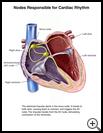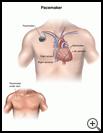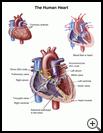
Pacemaker
What is a pacemaker?
Every normal heartbeat starts in a group of special pacemaker cells in the upper right chamber of the heart. These cells send a regular electrical signal that causes the heart to contract (squeeze) and push blood into other parts of the heart and out to the body. When the heart cannot beat regularly because of a problem with the electrical signal or damage to the heart, a pacemaker may be needed.
A pacemaker is a small battery-powered device that helps your heart beat in a normal rhythm. The pacemaker device is placed under the skin in your chest or belly. You will be able to feel the device under your skin. It’s about the size of a large watch. The pacemaker is attached to wires that deliver electrical signals to your heart. Your healthcare provider sets it to check your heart rhythm and send electrical signals to your heart, if needed. The electric signals cause your heart to beat in a regular pattern. You will not feel the electrical rhythm that is generated by the pacemaker.
The pacemaker runs on battery, and the battery will need to be replaced regularly as determined by your healthcare provider.
How is a pacemaker insertion done?
Before the procedure:
- Your healthcare provider will ask you to sign a consent form for the procedure. The consent form will state the reason you are having the procedure, what happens during the procedure, and what you may expect afterward.
- There is risk with every treatment or procedure. Talk to your healthcare provider for complete information about whether any of these risks apply to you:
- Anesthesia problems
- Bleeding
- Blood clots
- Infection
- Tell your healthcare provider if you have any food, medicine, or other allergies such as latex.
- Tell your healthcare provider if you are taking any medicines, including nonprescription drugs, herbal remedies, or recreational or illegal drugs.
- You will have a small tube (IV catheter) inserted into a vein in your hand or arm. This will allow medicine to be given directly into your blood and to give you fluids, if needed.
During the procedure:
- You may be given a sedative through your IV to help you to relax.
- You will be given medicines to prevent pain during your surgery. These may include:
- Local anesthesia, which numbs the area where the pacemaker will be inserted
- General anesthesia, which relaxes your muscles and puts you into a deep sleep. It also keeps you from remembering the operation. While you are asleep, you will have a tube in your throat to help you breath and to make sure you are getting enough oxygen. The tube may be removed before you wake up after the surgery.
- The surgeon will use a large needle to insert the pacemaker leads into a large blood vessel in your upper chest and then thread them into the heart. The provider will use a type of X-ray to guide the leads to the right place in your heart.
- The surgeon will connect the leads to the pacemaker and test that the leads are in the right place.
- The surgeon will make a cut in the upper chest or abdomen to insert the pacemaker just under the skin.
- The cut will be stitched closed.
After the procedure:
- You may stay in the hospital for a few hours or several days to recover, depending on your condition.
- While you are in the hospital, you will be checked often by nursing staff.
- There will be a dressing on the pacemaker insertion site. The dressing will be checked and changed by your provider or the nursing staff as needed.
- Your provider may prescribe medicine to:
- Treat pain
- Treat or prevent an infection
- Help prevent blood clots
- Control cholesterol levels
- Reduce fluid build-up and swelling in the body
- Your provider may recommend other types of therapy to help relieve pain, other symptoms, or side effects of treatment.
- Your blood oxygen level may be monitored by a sensor that is attached to your finger or earlobe.
- A cardiac (heart) monitor will be used to keep track of your heart rate and rhythm.
What can I do to help?
- You will need to tell your healthcare team if you have new or worsening:
- Chest pain or pressure, squeezing, or fullness in the center of your chest that lasts more than few minutes, or goes away and comes back (may feel like indigestion or heartburn)
- Pain or discomfort in one or both arms or shoulders, or in your back, neck, jaw, or stomach
- Trouble breathing
- Breaking out in a cold sweat for no known reason
- If your provider has prescribed nitroglycerin for angina, pain that does not go away after taking your nitroglycerin as directed
- Along with the previous symptoms, feeling very tired, faint, or sick to your stomach.
- Dizziness or lightheadedness
- Feeling like your heart is beating too fast, too slow, or skipping beats
- Redness, swelling, pain, warmth, or drainage from your surgical wound
- Fever, chills, or muscle aches
- Swelling of your legs, ankles, or feet
- Trouble breathing
- Ask questions about any medicine, treatment, or information that you do not understand.
How long will I be in the hospital?
How long you stay in the hospital depends on many factors. The average amount of time to stay in the hospital for a pacemaker procedure is 4 to 5 days.
Last modified: 2016-05-17
Last reviewed: 2016-05-16



